Gliders in the NSW Murray region
NRM NEWS – MAY 2021 – TERRESTRIAL ECOSYSTEMS
By Tracy Michael
Land Services Officer P: 02 6051 2211 | M: 0427 468 489 | E: tracy.michael@lls.nsw.gov.au
The Murray region is home to six gliding possum species, from the world's tiniest gliding mammal, the Feathertail Glider, to the largest glider, the Greater Glider.
All species of gliding possums have a membrane (called a patagium) which is a thin sheet of skin that stretches either between the forepaws and ankles or between the elbow and knee. This membrane lets them stretch their arms out and glide as they leap between trees as they forage for food and move through the landscape.
Feathertail Glider Acrobates pygmaeus and Acrobates frontalis
This tiny animal is the world's smallest gliding mammal. With a head and body length of only 65-80 mm, and weighing only 12 g, its size is comparable to a house mouse. Its distinctive tail has very short fur on the upper and lower surfaces with a noticeable fringe of long stiff hairs on either side, looking very much like a feather. They use their tail to steer and brake before landing as they glide through the trees. The small size of this animal makes it difficult to see when gliding. Often it may resemble a falling leaf! An average gliding distance for a Feathertail Glider is 14 m; however, they have been observed gliding up to 28 m.
Feathertail gliders spend most of their time in the canopy of eucalypts feeding on nectar, pollen and insects. Breeding occurs between July and February, with three to four young born in a litter. Feathertail Gliders are short-lived, three years on average. They can nest in groups of up to 20 individuals and will use tree hollows, nest boxes and old possum dreys. These gliders can enter a state known as torpor, different to hibernation, which can last from hours to days, dropping their temperature to as low as 2°C to reduce heat loss and conserve energy. Predators of this tiny glider include currawongs, kookaburras, foxes and cats.
There are two species of Feathertail Glider in our region, the Narrow-toed (Acrobates pygmaeus) and Broad-toed (Acrobates frontalis). Yes, it is the width of the toe that separates these species! Both species occur in our catchment with overlapping distributions in the Upper Murray. The Narrow-toed Feathertail Glider prefers cooler wetter forests, whereas the Broad-toed Feathertail Glider prefers warmer inland climates and extends further west along the Murray River corridor.
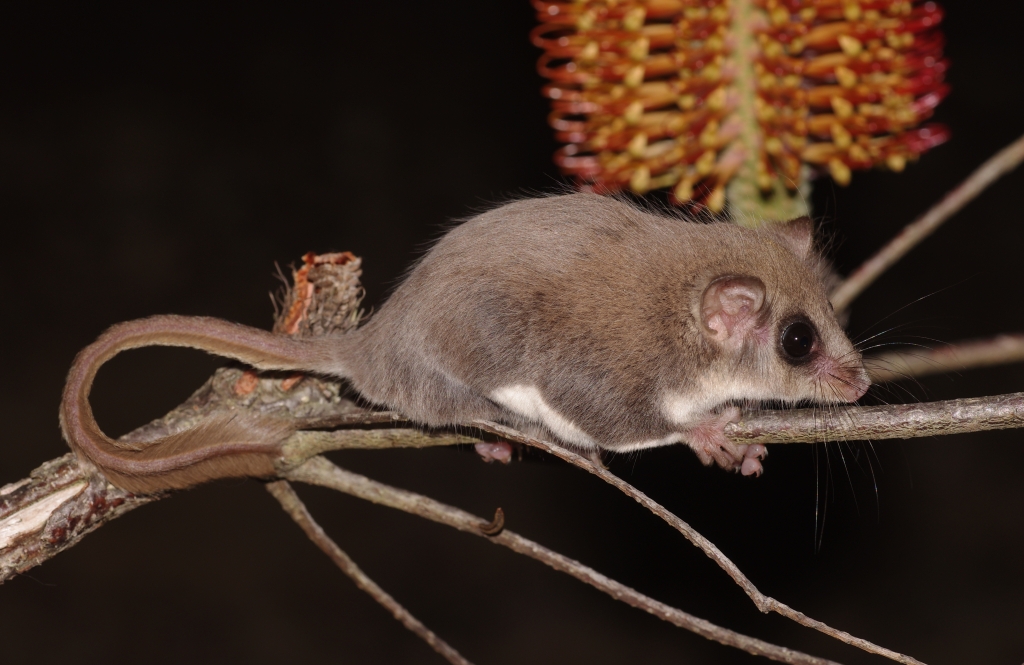
Krefft's Glider Petaurus notatus
The Sugar Glider has recently been split into three genetically and physically distinct species – Krefft's Glider (Petaurus notatus), Savanna Glider (Petaurus ariel) and Sugar Glider (Petaurus breviceps). Krefft's Glider can be found in our area, whereas the Sugar Glider is more typically found in coastal regions and the Savannah Glider in northern Australia. The Krefft's Glider weighs 95-135 g (females), 115-160 g (males) with a head and body length of 160-210 mm and a tail length of 165-210 mm. It is similar to the Squirrel Glider but is usually smaller with a less bushy tail at the base and a blunter face.
They require multiple tree hollows for nesting and shelter to live in social groups with up to seven adults and their young. Breeding season begins in June, with females generally giving birth to two young, sometimes only one. Around ten months of age, juveniles disperse from the nest, looking for new territory. Mortality can be high at this time due to predation by owls, goannas, foxes and cats. The lifespan of a Krefft's Glider is usually short, only four to five years.
Krefft's Glider feeds on gum produced by wattles (Acacia spp.), pollen, nectar and insects. In cold weather, they may huddle with others or enter torpor to conserve energy. They can glide up to 50 m between trees. Connectivity between patches of vegetation is essential in fragmented landscapes, so they may avoid coming down to the ground where they are at greater exposer to predators. They are typically found east of the Hume Highway, with some records extending west along the Murray River in our region.
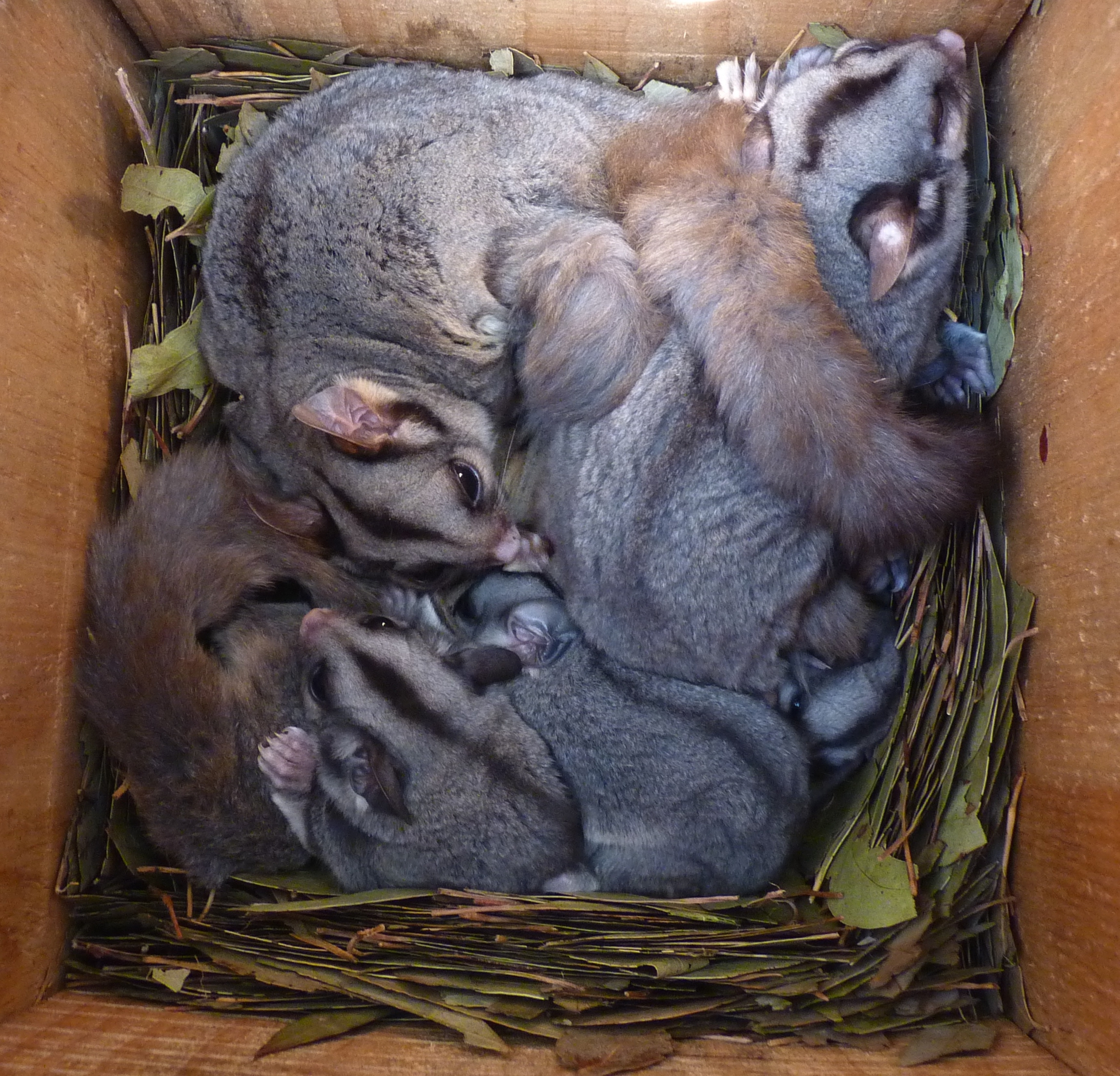
Squirrel Glider Petaurus norfolcensis
Conservation status in NSW: Vulnerable
The Squirrel Glider weighs between 190-300g with a head and body length of 180-230 mm with a bushy tail 220 -300 mm in length. With a similar appearance and gliding ability to the Krefft's Glider, they can be easily mistaken. Their diet, breeding, lifespan and social behaviour is very similar to Krefft's Glider, see above. They use up to 19 different tree hollows in a season, making large mature hollow-bearing trees an essential habitat requirement for this species.
Squirrel Gliders inhabitat dry forest and woodlands throughout the wheat sheep belt, which have typically been heavily cleared and modified for agricultural purposes. These gliders are considered rare throughout their range leading to the species listed under the NSW Biodiversity Conservation Act 2016. They glide up to 80 m, but 25 m is the typical average glide distance in woodland habitat. Gaps between trees and vegetation patches greater than 40 m are considered a barrier to Squirrel Glider movement making connectivity a critical conservation measure to limit their need to come to the ground exposing them to predators such as foxes and cats.
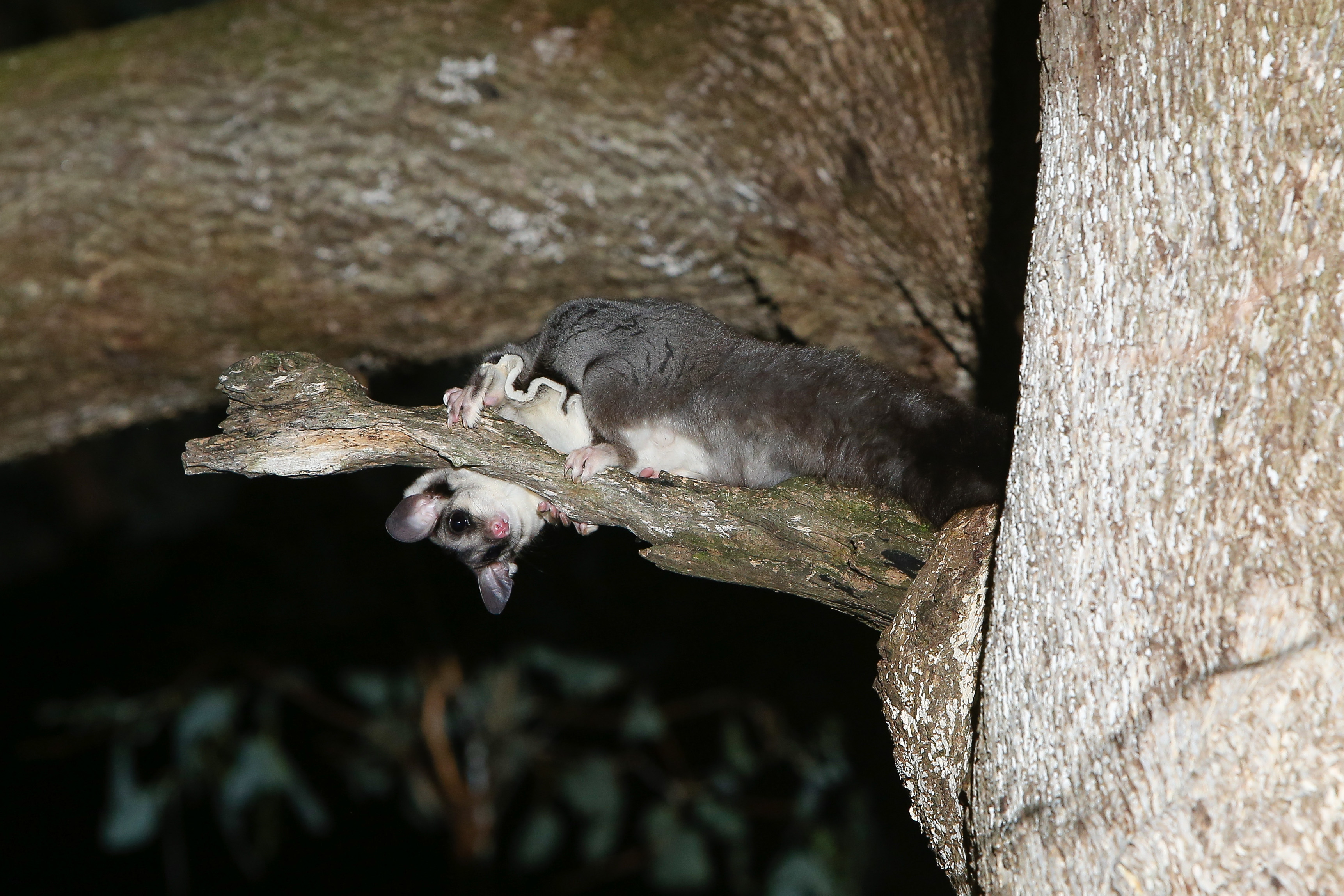
Yellow-bellied Glider Petaurus australis
Conservation status in NSW: Vulnerable
The Yellow-bellied Glider weighs 450-700 g, with a head and body length of 300 mm and a large bushy tail approximately 450 mm long. Its cream to yellow coloured belly is a notable feature. Yellow-bellied Gliders can be very vocal with a distinctive territorial call, a short high-pitched shriek subsiding into a throaty rattle that can be heard up to 400 m away. With large home ranges of up to 85 hectares, they are very mobile, searching for seasonally variable food resources, spending much of their waking hours foraging for food, travelling up to 2 km per night. They feed on honeydew, pollen, insects and spiders. Eucalypt sap makes up the bulk of their diet. They access the sap by biting out a 'V' shaped scar on a tree's trunk or main branches. Trees can often become heavily scarred as new excisions are made once sap dries up.
They require tree hollows for nesting and shelter with a preference for living trees, often living in family groups of two to six individuals, using up to eight different tree hollows within their home range. They typically give birth to single young with a life expectancy of approximately ten years. Within our region, they are found in the Upper Murray amongst tall mature eucalypt forest, generally in areas of high rainfall with nutrient-rich soils. With a need for a variety of trees to feed on, multiple tree hollows to nest in and a large home range, preservation of large tracts of land are an important conservation measure for this species.
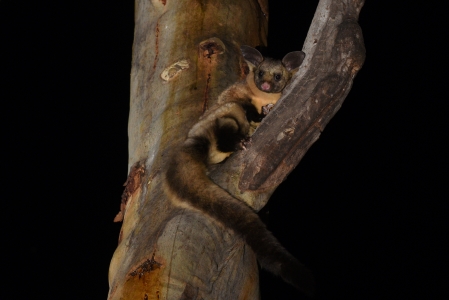
Greater Glider Petauroides volans
Commonwealth conservation status: Vulnerable
The Greater Glider is the largest gliding possum with a head and body length of 350-450 mm, a tail length of 450-600 mm and weigh 900-1700 g. They are primarily solitary animals requiring multiple large tree hollows for shelter, with home ranges of up to three to four hectares. The diet of a Greater Glider is almost exclusively eucalypt leaves, only eating the leaves of some eucalypt species high up in the canopy.
They typically give birth to single young, with a life expectancy estimated at 15 years. Greater Gliders are sensitive to habitat alteration and fragmentation and rely on patches of old-growth habitat. They can glide up to 100 m with their tail acting as a rudder, steering the body. If they come down to the ground, they can be clumsy and have difficulty crossing open tree-less areas and exposing them to predators such as the Powerful Owl and foxes. They can be found in sites extending east from Woomargama National Park to the Upper Murray region.
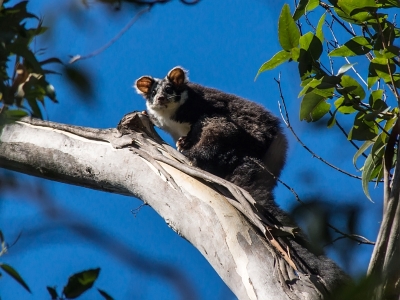
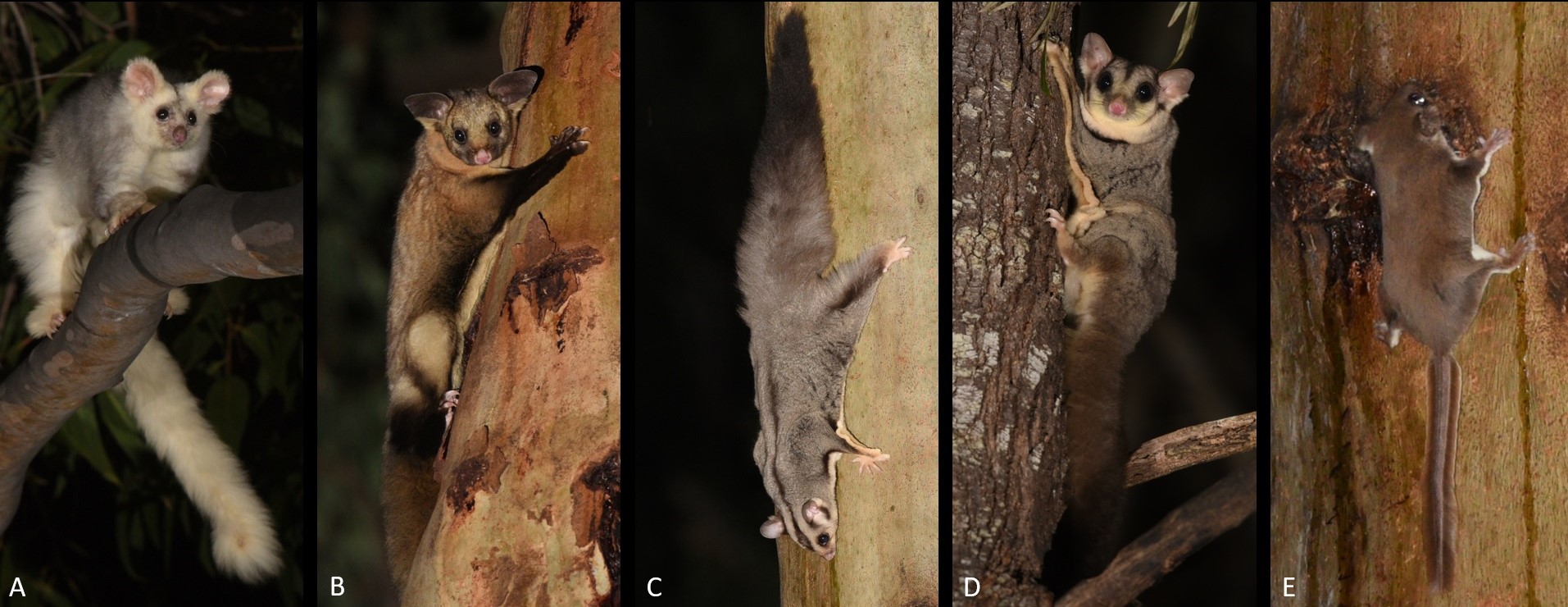
A: Greater Glider, B: Yellow-bellied Glider, C: Squirrel Glider, D: Krefft's Glider, E: Feathertail Glider (Wild for Wildlife - CC).